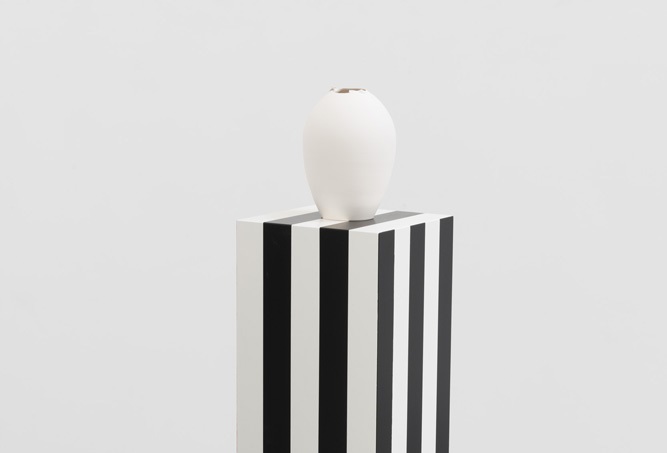


Grace Schwindt, The Tiffany Vase 4, 2014. Wood, acryl paint and porcelain, 137 x 26 x 26 cm. Image courtesy the artist.
Walking through a beautiful 1950s apartment in South London to the back bedroom/gallery, the setting is appropriately domestic to be a confronted by a vase just inside the doorway. At first glance it appears a minimalist object set atop a strangely textured black plinth which closer inspection reveals to be charred. Looking again at the vase it is tall and shapely but something has happened to the lip, which is damaged and asymmetrical. Positioned at a 45-degree angle, another such plinth bears a more rotund vase with the same defect. Both are made of dull white, unglazed porcelain. This pair impedes entrance to the room.
Zigzagging inside are three other plinths, one also charred, one in metal and one with black Buren-like stripes. Any suggestion of museological display is subverted by the colour and haphazard positioning of the plinths. Each carries a vase in a minor variation on the classic form; one with a larger lip, one with no lip, one with more pronounced shoulders, one with a foot. All are all made of the same light absorbing, unglazed porcelain and all contain the same flaw at the rim. In fact this is a scar of the making process.
Porcelain is notoriously the most fragile and least forgiving of clays. These vases have been thrown and caught just at the very moment of disintegration as the structure starts to break apart on the spinning wheel. They are eternally frozen at this moment of collapse, on the verge of a nervous breakdown. The vases are undecorated and empty, unfinished yet unfinishable.
Whereas Keats celebrated the eternally suspended action on a Grecian Urn – ‘When old age shall this generation waste / Thou shalt remain’ – for Schwindt it's the act of making that is arrested at the point of irreparable damage. The reassertion of gravity is a return of a repressed corporeal frailty that can no longer keep the spectre of death at bay. The flawed vase suggests the doomed creative process of creating a ‘pure’ memory. Memories of traumatic events are fragmented, not sequenced; details can be missing or confused. ‘The Past is never dead. It’s not even the past.’, to borrow William Faulkner’s oft-quoted words.
The story behind these strangely seductive vases is that they are re-imaginings of a vase described to Schwindt by a German émigré in New York. This interview was one of a series Schwindt has conducted with relatives and strangers, using it as source material in her examination of German history and how we live together today.
The vase, designed by Tiffany around 1910, was a family heirloom, all that remained after escaping Germany’s violent twentieth century. It has become a metonym for the family’s tragic history, an Ur-carrier of their memories; so much so that that the woman in question would not show the object to the artist. Was this because it was too precious to risk with a stranger or was it in fact no longer extant but still persisted as a lightning rod and leitmotif to her family story of loss across the generations? We are not party to the anonymous woman’s life story, its unknowability is made manifest in the absent vase. The delicacy of the porcelain reminds us of the fragility of human memory as well as the repression we need in order to survive.
In her practice, Schwindt looks at how objects become the bearers and creators of memories that are mutable and unreliable. A vase stands in for the body, the vocabulary we use to describe them is corporeal: mouth, lip, neck, shoulder, foot; and often gendered female, the womb as ‘vessel’, the once-prized ‘porcelain’ skin. It also evokes an urn, the last resting place for our body as ashes.
The Tiffany vase is first referred to in Schwindt’s film Tenant (2012) which explores how memories are inherited through objects. It probes Hannah Arendt’s assertion that the reality and reliability in our world depends on things that surround us, rather than on our activities. Domestic objects such as a vase can be used to keep memories active and confirm a certain construction of reality as well as substituting for lost loved ones. We are responsible for the objects entrusted to us, and the histories they contain, and this provokes anxiety. The vase owner lived in constant fear of it being broken and her family history being forgotten.
Curator Rose Lejeune set up Gallery Lejeune, an innovative art space in her home in 2015. Her exciting exhibition programme explores the ways in which participatory, performative and ephemeral work can be presented and collected in a domestic context and has included Florence Peake, William Hunt, Emma Hart and Joe Moran. Her exhibitions are built around events such as dinners, performances and talks. Gallery Lejeune is part of Lejeune’s wider commissioning and research project Collecting the Ephemeral that explores the role of collections in contemporary culture. She is currently Associate Curator for Delfina Foundation’s Collecting as Practice programme and a PhD candidate at Goldsmiths College working on the art market and participation.
Ali MacGilp
Programmes Manager
Gallery Lejeune is located in London SE22 close to East Dulwich and Peckham Rye stations. The exhibition is open during events and by appointment – please email gallerylejeune@gmail.com to arrange a visit and details will be given upon request. Exhibition continues until Sunday 26 November 2017. www.gallerylejeune.com